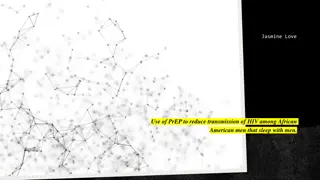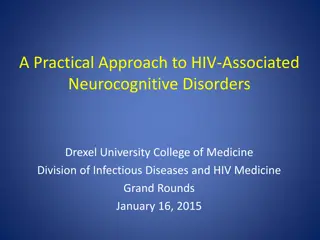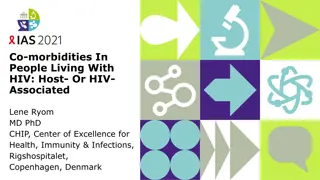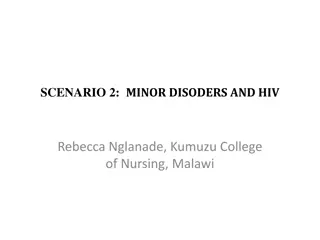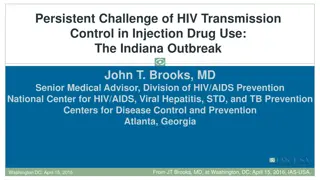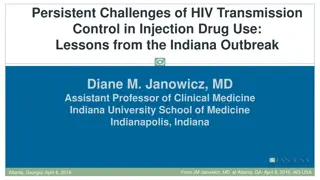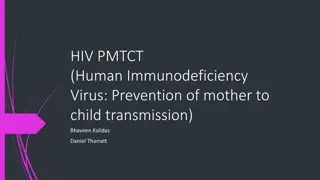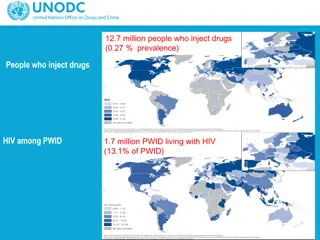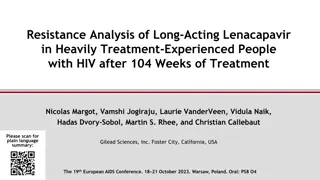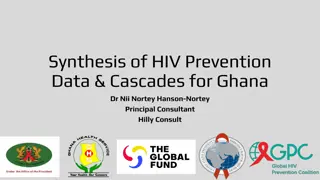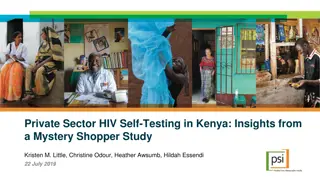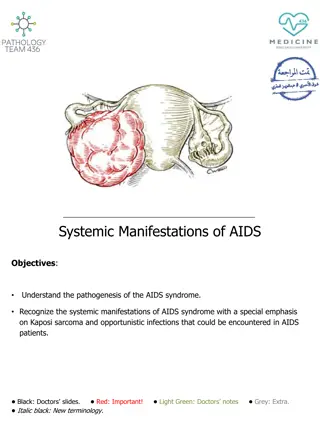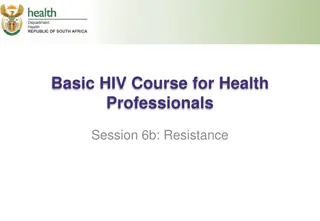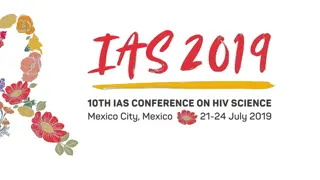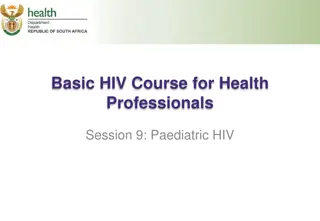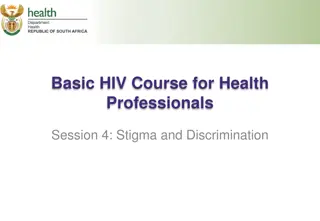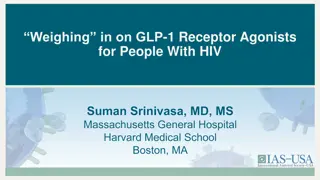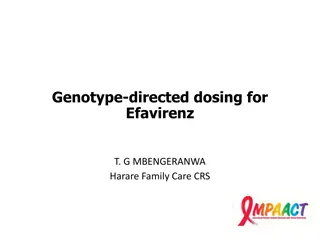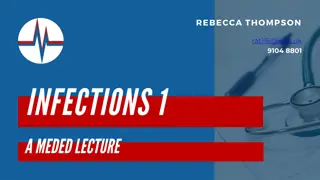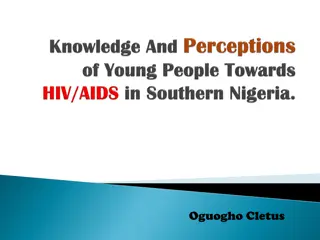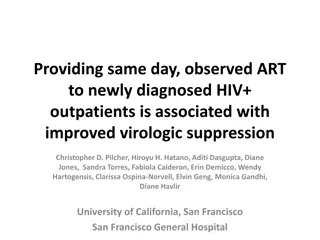Understanding HIV Transmission Risk Factors - Interactive Game Session
Explore HIV transmission risk factors through an interactive game session involving scenarios like number of sexual partners, infant born to a woman with HIV, unprotected sex, and more. Participants will assess the level of risk associated with each scenario in a fun and engaging learning experience.
Uploaded on Sep 28, 2024 | 0 Views
Download Presentation

Please find below an Image/Link to download the presentation.
The content on the website is provided AS IS for your information and personal use only. It may not be sold, licensed, or shared on other websites without obtaining consent from the author. Download presentation by click this link. If you encounter any issues during the download, it is possible that the publisher has removed the file from their server.
E N D
Presentation Transcript
HIV Fundamentals Bluefield State College August 18, 2020 Carolyn Kidd RN ACRN Clinical Nurse Educator MidAtlantic AETC 1
Speaker Disclosure Speakers are required to disclose any commercial relationships before today s presentation. MidAtlantic AIDS Education and Training Center
Lets Play MidAtlantic AIDS Education and Training Center 3
Red light, green light game This game is related to transmission of HIV: Facts, falsehoods and misconceptions How to play: I ve chosen several different risk factor behaviors related to HIV transmission. I ll have one slide for each risk factor and you will determine via polling ability whether it is: Red check (No = not a good idea, stop) = high risk Gray check (go slower) = potential risk Green icon = for little/no risk We will discuss the poll responses to each slide MidAtlantic AIDS Education and Training Center 4
Lets get started! Number of sexual partners Red icon for high risk Gray icon for potential risk Green icon for little/no risk MidAtlantic AIDS Education and Training Center 5
Baby born to a woman with HIV Red icon for high risk Gray icon for potential risk Green icon for little/no risk MidAtlantic AIDS Education and Training Center 6
Unprotected sex Red icon for high risk Gray icon for potential risk Green icon for little/no risk MidAtlantic AIDS Education and Training Center 7
Sharing or buying breastmilk for personal use Red icon for high risk Gray icon for potential risk Green icon for little/no risk MidAtlantic AIDS Education and Training Center 8
Presence of Sexually Transmitted Infections Red icon for high risk Gray icon for potential risk Green icon for little/no risk MidAtlantic AIDS Education and Training Center 9
Intimate Partner Violence Red icon for high risk Gray icon for potential risk Green icon for little/no risk MidAtlantic AIDS Education and Training Center 10
Clean syringes and works for persons who inject substances Red icon for high risk Gray icon for potential risk Green icon for little/no risk MidAtlantic AIDS Education and Training Center 11
Sexual intercourse with a person with HIV whose viral load is suppressed Red icon for high risk Gray icon for potential risk Green icon for little/no risk MidAtlantic AIDS Education and Training Center 12
Blood donation Red icon for high risk Gray icon for potential risk Green icon for little/no risk MidAtlantic AIDS Education and Training Center 13
Alcohol and substance misuse Red icon for high risk Gray icon for potential risk Green icon for little/no risk MidAtlantic AIDS Education and Training Center 14
Women who have sex with other women Red icon for high risk Gray icon for potential risk Green icon for little/no risk MidAtlantic AIDS Education and Training Center 15
HIV-1 Infection Initial description and early spread: Morbidity and Mortality Weekly Report (MMWR) June 5 1981, described Pneumocystis jiroveci pneumonia in men who have sex with men (MSM), LA and NYC July 1981, patients with Kaposi s sarcoma reported Many causes considered: lifestyle, other infectious agents, drug abuse HIV itself was not identified for another 2 years The HIV epidemic spread rapidly and silently in the absence of testing Problem became designated as Acquired Immune Deficiency Syndrome (AIDS) 1.Barre-Sinoussi F, Chermann JC, Rey F, Nugeyre MT, Chamaret S, Gruest J, et al. Isolation of a T-lymphotropic retrovirus from a patient at risk for acquired immunodeficiency syndrome (AIDS). Science. May 20 1983;220(4599):868-71. MidAtlantic AIDS Education and Training Center
HIV-1 Infection Background: Blood-borne, sexually transmissible Typically sexual intercourse, shared IV drug paraphernalia, mother to child (MTCT) Most common route of infection varies from country to country, within cities (depends on how HIV was introduced initially and local practices) Two distinct species HIV-1 and HIV-2 each has it s own genes and distinct replication process MidAtlantic AIDS Education and Training Center
HIV-1 Infection 1982 four identified risk factors: homosexuality, IV drug abuse (heroin), Haitian origin, Hemophilia A GRID used by media & HCP , mistakenly suggesting inherent link b/t homosexuality and the Syndrome 1983 US Public Health Service issues prevention recommendations: sexual transmission, transfusions CDC adds female sex partners of men with AIDS as 5th risk group 1984: San Francisco orders bathhouses closed CDC recommends abstention from IV substance misuse/reduction in needle sharing MidAtlantic AIDS Education and Training Center
HIV-1 Infection 1985 CDC releases 1st recommendations for prevention of Mother-To-Child-Transmission (MTCT) 1st screening tool to detect HIV antibodies approved by FDA Screening of US blood supply Ryan White speaks publically against AIDS stigma/discrimination MidAtlantic AIDS Education and Training Center
HIV-1 Infection 1986 AZT, the 1st drug used to treat AIDS, begins clinical trials Informal distribution of clean syringes begins in Boston & New Haven MidAtlantic AIDS Education and Training Center
HIV-1 Infection 1987 1st ARV approved by the FDA to treat AIDS: accelerated drug approval ACT UP established in NYC in response to proposed cost of AZT: price lowered HIV Prevention: a new indicator for condom use MidAtlantic AIDS Education and Training Center
HIV-1 Infection 1989-1990 1989: 1st guidelines issued for prevention of Pneumocyctis Jiroveci Pneumonia (PCP) 1990: Beginning to see information regarding women and HIV MidAtlantic AIDS Education and Training Center
HIV-1 Infection 1991-1996 1991: Red ribbon introduced as the international symbol of AIDS awareness 1993: USPHS recommends use of AZT in pregnancy to reduce perinatal transmission (ACTG 076) 1996: Viral load analysis approved by the FDA MidAtlantic AIDS Education and Training Center
HIV-1 Infection 1997-98 1997: AIDS-related deaths decrease by >40% due to Highly Active Anti-retroviral Therapy (HAART) 1998: beginning to see growing signs of treatment failure/side effects of HAART MidAtlantic AIDS Education and Training Center
HIV-1 Infection 2002-2012 2002: women comprise about of adults living with HIV globally 2004: Ora-Quick rapid HIV test approved by the FDA 2011: Results from the HPTN 052 trial show that early initiation of antiretroviral treatment reduces the risk of HIV transmission by 96% among discordant couples Pre-exposure prophylasis (PrEP) 2012: UNAIDS release new guidelines regarding ARV treatment as prevention, for serodiscordant couples MidAtlantic AIDS Education and Training Center
HIV-1 Infection 2013-2016 2013: UNAIDS reports AIDS-related deaths down 30 percent since their peak in 2005 2014: UNAIDS report shows that 19 million of the 35 million people thought to be living with HIV do not know their status 2015: START trial data released, PrEP Strategic Timing of Antiretroviral Treatment 2016: START is now standard of care MidAtlantic AIDS Education and Training Center 26
HIV-1 Infection 2017-2019 2017, 2018, 2019: New HIV drugs and drug class, dual therapies, new prevention models national case decreases but still stagnant HIV outbreaks among intravenous drug users (IDUs) syringe services programs MidAtlantic AIDS Education and Training Center 27
HIV/AIDS MidAtlantic AIDS Education and Training Center
Epidemiology of HIV/AIDS in the United States
HIV in the United States 2017 About 1.12 million people with HIV 1 in 8 unaware of their infection (12.8%) New HIV cases: 35-40,000 every year . Stagnant but increased diagnoses in some populations in the US Ages 25-34 years account for 13,433 new diagnoses Gay, bi- and other MSM particularly, young black MSM, are most seriously affected by HIV By race, blacks face the most severe burden of HIV 12% US population, 44% new infections Unless the epidemic course changes, at some lifetime point 1 in 16 black men and 1 in 32 black women will be diagnosed with HIV https://www.cdc.gov/hiv/statistics/overview/ataglance.html. Accessed August 23, 2019 MidAtlantic AIDS Education and Training Center
HIV in the United States 2019 Black MSM in the US most profoundly affected Demographic: deep south Behavioral: unprotected receptive anal sex Economic: employment rates, college education, income Biological: prevalence of STIs, rectal lining thin Urgent need for better promotion of sexual health, prevention interventions, addressing socioeconomic, behavioral health to decrease HIV incidence .. Mayer KH et al. Concomitant socioeconomic, behavioral, and biological factors associated with the disproportionate HIV infection burden among black men who have sex with men in 6 U.S. cities. PLOS ONE 9 (1): e87298, 2014. MidAtlantic AIDS Education and Training Center
Diagnoses of HIV Infection among Adults and Adolescents, by Race/Ethnicity 20102016 United States and 6 Dependent Areas a Hispanics/Latinos can be of any race.
Diagnoses of HIV Infection among Adults and Adolescents, by Transmission Category, 2010 2016 United States and 6 Dependent Areas Note. Data have been statistically adjusted to account for missing transmission category. Other transmission category not displayed as it comprises less than 1% of cases. a Heterosexual contact with a person known to have, or to be at high risk for, HIV infection.
Diagnosed HIV Infections Attributed to Injection Drug Use, by Sex and Race/Ethnicity, 2017 United States and 6 Dependent Areas Note. Data for the year 2017 are considered preliminary and based on 6 months reporting delay. Data have been statistically adjusted to account for missing transmission category. a Hispanics/Latinos can be of any race. b Because column totals for numbers were calculated independently of the values for the subpopulations, the values in each column may not sum to the column total.
WV HIV/AIDS Surveillance Summary Updated 2018: Cumulative through 2017 HIV not AIDS: 1144 HIV/AIDS: 1870 By gender Male 853 Female 291 By race White 733 African American 344 Hispanic 32 Other: includes hemophilia, blood transfusion, and risk not reported or not identified 154 https://dhhr.wv.gov/oeps/std-hiv-hep/HIV_AIDS/Documents/HIV%20Surveillance%20Summary%202018.pdf. Accessed July 31, 2020 MidAtlantic AIDS Education and Training Center
WV HIV/AIDS Surveillance Report Updated 2017 Exposure category MSM 568 Injection drug use (IDU) could this be an ongoing concern in the era of COVID19? MSM/IDU 50 Heterosexual contact 180 Perinatal 13 Other/Unknown 154 Includes hemophilia, blood transfusion, risk not reported https://dhhr.wv.gov/oeps/std-hiv-hep/HIV_AIDS/Documents/HIV%20Surveillance%20Summary%202018.pdf. Accessed August 23, 2019 MidAtlantic AIDS Education and Training Center
HIV Transmission MidAtlantic AIDS Education and Training Center 37
Modes of Transmission Sexual contact (unprotected) M-M: (most frequently reported risk) M-F or vice versa F-F Blood exposure Substance Use Disorder: Injection Drug Use/Needle sharing Occupational Transfusion Mother to Child (MTCT ) Vertical Breastfeeding MidAtlantic AIDS Education and Training Center
Biological Factors That Affect Sexual Transmission Blood and genital viral load suppression Acute infection or advanced disease Genital ulcerations Inflammatory STIs: acquisition of HIV Cervical ectopy: covered by a single layer of columnar epithelium that is: Highly susceptible to HIV The site of HIV receptor cells (CCR5) HAART (Highly Active Anti-Retroviral Therapy) MidAtlantic AIDS Education and Training Center
Infectious Body Fluids Blood Semen Vaginal secretions Breastmilk 1. Gaur AH, Dominguez KL, Kalish ML, et al. Practice of feeding premasticated food to infants: a potential risk factor for HIV transmission. Pediatrics 2009;124:658-66. MidAtlantic AIDS Education and Training Center
Other Body Fluids Considered potentially infectious: Cerebrospinal Synovial Pleural Peritoneal Pericardial Amniotic Pus MidAtlantic AIDS Education and Training Center
Other Body Fluids Not infectious unless visibly bloody: feces, urine nasal secretions, sputum saliva sweat tears vomitus MidAtlantic AIDS Education and Training Center
Natural History of HIV Infection Viral Transmission Virus immediately harbored in the gut-associated lymphoid tissue (GALT) Within 2-3 wks leads to: Acute HIV infection Peak viremia sx may last about 1-2 weeks Recovery and seroconversion Asymptomatic chronic HIV infection avg 8 years Symptomatic HIV infection avg 1.3 years AIDS Death MidAtlantic AIDS Education and Training Center
Lab tests to support therapy in HIV infection Viral Load Assay: Indicates the current level of circulating virus CD4 T cell counts: Measure the current ability of the immune system to protect the body Combination of the 2 provides the best information for initiating, monitoring and changing Highly Active Antiretroviral Therapy (HAART) MidAtlantic AIDS Education and Training Center
Acute HIV Infection (AHI) Symptoms 2-3 weeks after exposure Can last 1-2 weeks Most symptoms usually resolve within 2 weeks w/o treatment Generally accepted: most clients will experience symptoms during this phase Persistence of symptoms may predict a more rapid progression to AIDS MidAtlantic AIDS Education and Training Center
AHI Very high degree of viremia (millions of virus particles) CD4 decreases by 20-40% due to HIV-induced cell death Up to 90% have acute viral syndrome Antibodies not present until after 1 mo. Due to very high level of viremia: >50% sexual transmissions occur during AHI MidAtlantic AIDS Education and Training Center
AHI Clinical presentation may mimic other febrile illnesses Symptoms non-specific Early diagnosis relies on history of exposure, viral load >50,000 copies/ml and a high degree of clinical suspicion MidAtlantic AIDS Education and Training Center
AHI: Common Signs & Symptoms fever 86 lethargy 74 myalgias 59 rash 57 headache 55 N = 160 patients with PHI in Geneva, Seattle, and Sydney pharyngitis 52 adenopathy 44 0 20 40 60 80 100 % of patients Vanhems P et al. AIDS 2000; 14:0375-0381. MidAtlantic AIDS Education and Training Center
AHI: Other Signs & Symptoms 24 aseptic meningitis 15 oral ulcers 10 genital ulcers 45 thrombocytopenia leukopenia 40 transaminitis 21 0 20 40 60 80 100 % of patients Kahn JO, Walker BD. N Engl J Med. 1998;339:33-39. MidAtlantic AIDS Education and Training Center







